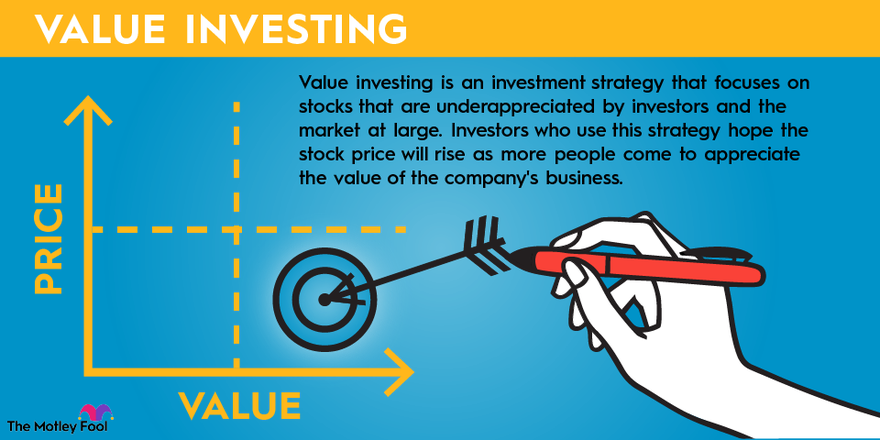Many investors are attracted to value stocks because of the possibility of generating outsize returns. But identifying stocks that the market has mispriced isn't easy and requires lots of research.
A value exchange-traded fund (ETF) is a fund that invests in a basket of value stocks. You can buy and sell value ETFs on an exchange, just as you would a stock. If you're interested in investing in value stocks but don't want to choose individual companies yourself, buying shares of a value ETF may be a good solution.

Value stocks have lagged behind the overall market since the Great Recession, but the market moves in cycles, and that trend could reverse.
An ETF that invests in value stocks may use specific criteria to find companies with intrinsic values that substantially exceed the market values implied by their stock prices. By investing in a wide range of undervalued companies, value stock ETFs confer instant portfolio diversification. Buying shares in a value stock ETF can be a safe and easy way to invest in companies in cyclical industries.
How do value ETFs work?
A value ETF works just like any other ETF, with the main difference being a focus on value stocks. An ETF will pool money from investors, similarly to a mutual fund. A fund manager will select investments for the ETF portfolio. That selection could be automatic by tracking an index or using an algorithm to filter a subset of stocks, or the fund manager may actively pick stocks.
One thing that separates an ETF from a mutual fund is that it trades on an exchange. That means you can buy or sell shares throughout the trading day; mutual funds trade only once per day after markets close. They're also easily transferred from one broker to another, which could make them preferable to mutual funds.
Top ETFs in 2025
Here are the best value stock ETFs for investors:
ETF | Ticker | Category |
|---|---|---|
Vanguard Value ETF | Best value ETF overall | |
Vanguard Value ETF | Best large-cap value ETF | |
Vanguard Mid-Cap Value ETF | Best mid-cap value ETF | |
Avantis U.S. Small Cap Value ETF | Best small-cap value ETF | |
iShares MSCI Intl Value Factor ETF | Best international large-cap value ETF | |
VictoryShares Emerging Markets Value Momentum ETF | Best emerging market value ETF | |
Vanguard High Dividend Yield ETF | Best value dividend ETF | |
Roundhill Acquirers Deep Value ETF | Best deep value ETF |
Best overall value ETF
The Vanguard Value ETF is the best overall option for investors seeking diversified portfolio exposure to value stocks. With more assets under management than any other ETF in the sector, it tracks the CRSP Large Cap Value index by investing directly in its component companies. The ETF holds shares of the companies in the index in close proportion to their index weighting.

NYSEMKT: VTV
Key Data Points
The CRSP Large Cap Value index is predominantly composed of large-cap companies, but it also includes companies with relatively small market capitalizations, providing some exposure to mid-cap stocks.
Vanguard keeps transaction fees low for the ETF's shareholders by allowing the fund's proportional holdings to deviate slightly from the composition of the underlying index. Despite that allowance, the difference between the performances of the Vanguard Value ETF and the index it tracks is extremely low and among the best in the industry. The ETF's turnover was just 10.3% in 2024.
With an expense ratio of only 0.04%, investors don't pay much in fees, either. That makes the Vanguard Value ETF one of the least expensive and most efficient ways to invest in more than 300 value stocks.
Best large-cap value ETF
Buying shares in the Vanguard Value ETF is also the best way to gain exposure to undervalued large-cap companies. The ETF's low expense ratio, low turnover rate, and high performance correlation with the underlying index all suggest it is the best large-cap value ETF.
Despite the ETF's focus on large-cap companies, it still provides portfolio diversification for investors by not investing too heavily in any single stock. The ETF's top 10 holdings comprise about 20% of the fund's value, and the next 10 companies by market value account for another 11% of the ETF's value.
Best mid-cap value ETF
The Vanguard Mid-Cap Value ETF tracks the CRSP US Mid Cap Value index by owning stocks in proportion to their weightings in the index. The CRSP US Mid Cap Value index includes companies covering 70% to 85% of cumulative capitalization and identifies value stocks based on several metrics.

NYSEMKT: VOE
Key Data Points
Companies with high book values, projected earnings, historic earnings, dividends, or sales relative to their share prices are all potential targets for inclusion in the index.
Since the CRSP US Mid Cap Value Index is governed by more criteria, the ETF has a relatively high turnover rate, but that's an issue with all mid-cap value ETFs. With an extremely low expense ratio of just 0.07%, the Vanguard Mid-Cap Value ETF is a top way to gain exposure to medium-sized companies undervalued by the market.
Best small-cap value ETF
The Avantis U.S. Small Cap Value ETF is an actively managed small-cap value fund. Its benchmark index is the Russell 2000 Value index, which tracks the returns of companies with low price-to-book ratios and lower forecast growth values in the Russell 2000, an index that represents 2,000 of the smallest companies in the U.S.

NYSEMKT: AVUV
Key Data Points
Although technically an active ETF, the fund manager aims to maintain the benefits of indexing, such as diversification and low turnover. However, active management allows the fund to add value for investors by using current price and profitability information.
The Avantis U.S. Small Cap Value ETF gives investors more concentrated exposure to the small-cap value factor than most small-cap value index funds. The fund's turnover rate is very low relative to other small-cap value funds. While investors will pay an expense ratio of 0.25% (more than the average index fund), the premium provides investors with greater exposure to small-cap value stocks.
The combination of a passive philosophy and some active implementation may not be suitable for everyone since it involves the risk of underperforming the benchmark. Still, Avantis is one of the best ways to gain concentrated exposure to small-cap value stocks.
Best international large-cap value ETF
BlackRock's (BLK +0.22%) iShares MSCI Intl Value Factor ETF tracks the MSCI World ex USA Enhanced Value index. Although this ETF includes some mid-cap stocks, it mostly consists of large-cap companies, since the index is weighted by companies' market values.

NYSEMKT: IVLU
Key Data Points
The MSCI World ex USA Enhanced Value index comprises about 350 companies operating in 22 developed markets, with Japan, the U.K., France, and Germany accounting for most of its weight. The index determines which companies to include based on how a company's stock price compares to its book value or forward earnings or on how its enterprise value compares to its cash flow from operations.
The ETF's 0.30% expense ratio is higher than the one charged by many domestic ETFs. However, it is still an attractive option for investors seeking a global, value-oriented ETF.
Best emerging market value ETF
Investors seeking an ETF that provides portfolio exposure to undervalued companies in emerging markets can opt for shares in the VictoryShares Emerging Markets Value Momentum ETF. This ETF tracks the MSCI Emerging Markets Select Value Momentum Blend index, which selects companies for inclusion based on both value and growth momentum.

NASDAQ: UEVM
Key Data Points
The index assigns each included company a single score, giving more weight to companies with the lowest stock price volatility. Companies from China, South Korea, and Taiwan account for the majority of the index's weight.
The ETF uses representative sampling to track the underlying index, meaning the fund owns only a fraction of the stocks included in the index. Representative sampling by an ETF, while more efficient and cost-effective, reduces the correlation between the performance of the ETF and the index it tracks. The ETF's expense ratio of 0.45% is about average for emerging market ETFs.
Best value dividend ETF
Most stocks that pay dividends are considered value stocks. As such, investors will often find overlap in ETFs focused on value stocks and those focused on dividend stocks. And if you want a higher dividend yield than the average value stock ETF, you should consider the Vanguard High Dividend Yield ETF.

NYSEMKT: VYM
Key Data Points
The fund seeks to track the performance of the FTSE High Dividend Yield index, which includes all stocks with relatively high dividend yield forecasts. This forward-looking criterion ensures that the index's dividend yield remains consistently high.
Indeed, the recent yield on the Vanguard High Dividend Yield ETF is 2.4%, which is better than the Vanguard Value ETF by about 0.35 percentage points. Importantly, it maintains a tilt toward large-cap value stocks, so investors still gain exposure to value. The ETF charges an expense ratio of just 0.06%.
Best deep value ETF
Investors seeking exposure only to deeply undervalued stocks via an ETF can buy shares in Roundhill Acquirers Small and Micro Deep Value ETF. This ETF seeks to hold stocks that trade at a low enterprise value relative to operating earnings.

NYSEMKT: DEEP
Key Data Points
It does so by tracking the Acquirer's Small and Micro Deep Value index, which evaluates a company's financial statements using the same analysis that activist investors and buyout firms use to identify targets. It then removes companies with a statistical measure of fraud or financial distress.
The top 100 companies drawn from the smallest 75% of stocks listed in the U.S. are selected and equally weighted, and the index rebalances quarterly.
Despite having a relatively high expense ratio of 0.80%, the ETF remains a solid choice for investors focused on companies with the most unrecognized value. It does, however, produce a high turnover ratio as a result of algorithmically selecting 100 companies every quarter.
How to choose a value ETF
The first step to determining which value ETF is best for you is to determine what kind of value stocks you want to own.
Small-cap value has historically outperformed the market, but large-cap value stocks are generally less volatile. International stocks could provide exposure to companies outside the United States with more potential, but they come with additional sociopolitical risks. If you want to collect dividend income every year, plenty of dividend stocks offer attractive yields.
Once you determine the kind of stocks you want to own, you can choose the one that best fits your criteria from the list above. You can also make your own list. Be sure to pay attention to its expense ratio relative to similar ETFs. If it tracks an index, a low tracking error could be even more valuable for those investing additional cash into the ETF on a regular schedule.
Pros and cons of investing in value ETFs
Pros
- Downside protection: In a bear market, value stocks typically hold up better than the rest of the market.
- Diversification: Value ETFs can provide a diversifying factor to your portfolio.
Cons
- Less upside: Value stocks rarely climb as high or as fast as growth stocks.
- Industry concentration: Value ETFs are heavily weighted toward financials and energy stocks.
- Tracking error: Smaller indexes can introduce tracking error, leading to returns that don't match the index they're meant to match.
Related investing topics
How to invest in value ETFs
- Open your brokerage app: Log in to your brokerage account where you handle your investments.
- Search for the stock: Enter the ticker or company name into the search bar to bring up the stock's trading page.
- Decide how many shares to buy: Consider your investment goals and how much of your portfolio you want to allocate to this stock.
- Select order type: Choose between a market order to buy at the current price or a limit order to specify the maximum price you're willing to pay.
- Submit your order: Confirm the details and submit your buy order.
- Review your purchase: Check your portfolio to ensure your order was filled as expected and adjust your investment strategy accordingly.



